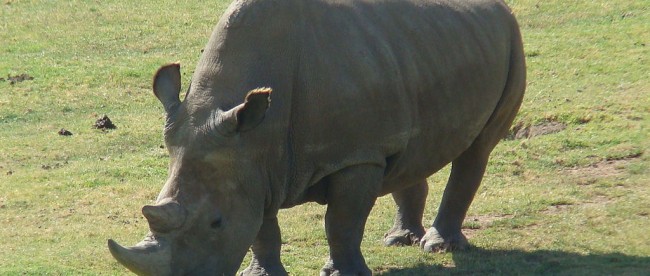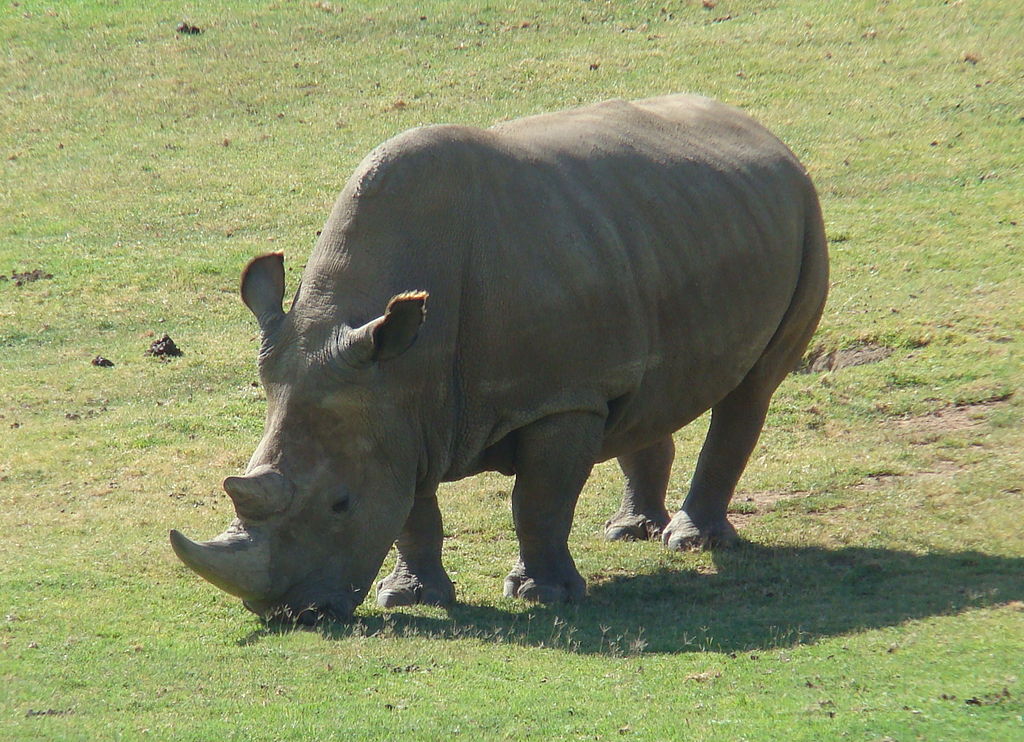Why Dyeing Rhinos May Keep Them From Dying

The white rhinoceros, pictured below, is classified as “near threatened,” as there are fewer than 20,000 such rhinos in the world. (One of the sub-species, the northern white rhino, is likely extinct in the wild, and may not be able to be bred in captivity as there are too few males left.) This is a massive improvement over the last century; in 1900, according to a website called Rhino Economics (really), there were only about 50 of the animals alive. But the animals are still at risk. Approximately 1,000 die at the hands of poachers every year.
To combat this, many experts are hoping the rhinos dye, instead.

The fact that rhinos are hunted in the first place is an oddity in itself. Rhino horns are made of keratin, the same material human hair and nails are made from. There’s nothing really special about the horns, at least not scientifically, but not everyone believes that. According to the Atlantic, in Vietnam at least, a few grams of rhino horn are believed (wrongfully) to be an effective treatment for cancer and/or a cocaine-like aphrodisiac, depending on your needs. That seems like a pretty small market, but it’s big enough to make rhino horns incredibly valuable. A horn can fetch $300,000 on the black market — a per-gram price which often outpaces that of gold.Unfortunately, rhinos neither shed their horns nor give them up too easily, especially not in the wild. So if you’re trying to procure a horn so you can grind it up and import it to Vietnam, you need to hunt — and typically kill — the rhino which currently owns it. That’s why the rhino population is dwindling. Anti-poaching efforts have run the gamut, including all-out war; in December 2014, for example, the New York Times reported that game rangers had killed three poachers after “an escalation of armed incursions into South Africa’s flagship wildlife reserve, where hundreds of rhinos have been killed for their horns” over the course of that year.
But there is potential for a less-violent, rhino-friendly solution — stop the poaching by rendering the horns worthless. That’s where dye comes in.
Anti-poaching experts have found a way to inject an ink solution into the insides of the animals’ horns. (The rhinos need to be tranquilized first, but it’s better than the alternative.) As Scientific American explains, the ink “is exactly the kind of indelible dye that is used for ruining bank robbers’ prey and tagging the thieves,” but in this case, turns a valuable horn into a worthless purple mess. And because of the anatomy of the horns, would-be poachers can’t simply avoid dyed rhinos — the horns, again per Scientific American, “can be soaked with the dye from inside without being noticeable from outside.” And as a kicker, the dye mix contains an anti-tick medication for the rhino — one which is toxic (but not fatal) if ingested by humans. So if you’re a Vietnamese guy looking for an expensive drug hit, going after rhino horn may land you in the hospital with a bad case of nausea.
Unfortunately, the dye isn’t quite where it needs to be yet — and may not get there. According to a reddit user claiming to be “guide/ranger on a game reserve in South Africa working closely with rhinos” (the linked-to post seems credible, but who knows), the dye doesn’t quite infiltrate the entire horn. As a result, “poachers can just cut the part where the substance has been injected in out and sell the rest of the horn,” and the resultant bounty is still worth enough to warrant the expense. But hopefully, the science behind the dye can be improved to the point where it makes rhino horns worthless for poachers to go after.
 Bonus Fact: There may be an even less-violent way to stop the poaching of rhinos: legalized horn harvesting. According to a second New York Times article, there’s a movement in South Africa to allow the sale of rhino horn in the nation. The chief proponents of such a change in the law are breeders of rhinos who, per the Time, argue that “rhino horns a renewable resource” as they grow back, and that “harvesting the horn from the living rhinos at their ranches and selling it legally will drive poachers currently slaughtering the endangered animals out of business.” The idea may not be a bad one — opinions among rhino experts are mixed. South Africa promised to revisit the issue in 2016, after the relevant next meeting of the Convention on International Trade in Endangered Species of Wild Fauna and Flora (CITES).
Bonus Fact: There may be an even less-violent way to stop the poaching of rhinos: legalized horn harvesting. According to a second New York Times article, there’s a movement in South Africa to allow the sale of rhino horn in the nation. The chief proponents of such a change in the law are breeders of rhinos who, per the Time, argue that “rhino horns a renewable resource” as they grow back, and that “harvesting the horn from the living rhinos at their ranches and selling it legally will drive poachers currently slaughtering the endangered animals out of business.” The idea may not be a bad one — opinions among rhino experts are mixed. South Africa promised to revisit the issue in 2016, after the relevant next meeting of the Convention on International Trade in Endangered Species of Wild Fauna and Flora (CITES).
From the Archives: The Honorable Mrs. Rhino: A political candidate who is, quite clearly, anti-poaching.
Take the Quiz: Where do rhinos live?
Related: “The Rhino Who Swallowed a Storm,” a book for kids age 5 to 7. I don’t know if it’s any good (the 5.7 stars on 57 reviews suggests it is), but it’s by LeVar Burton, so it has to be at least decent, right?
